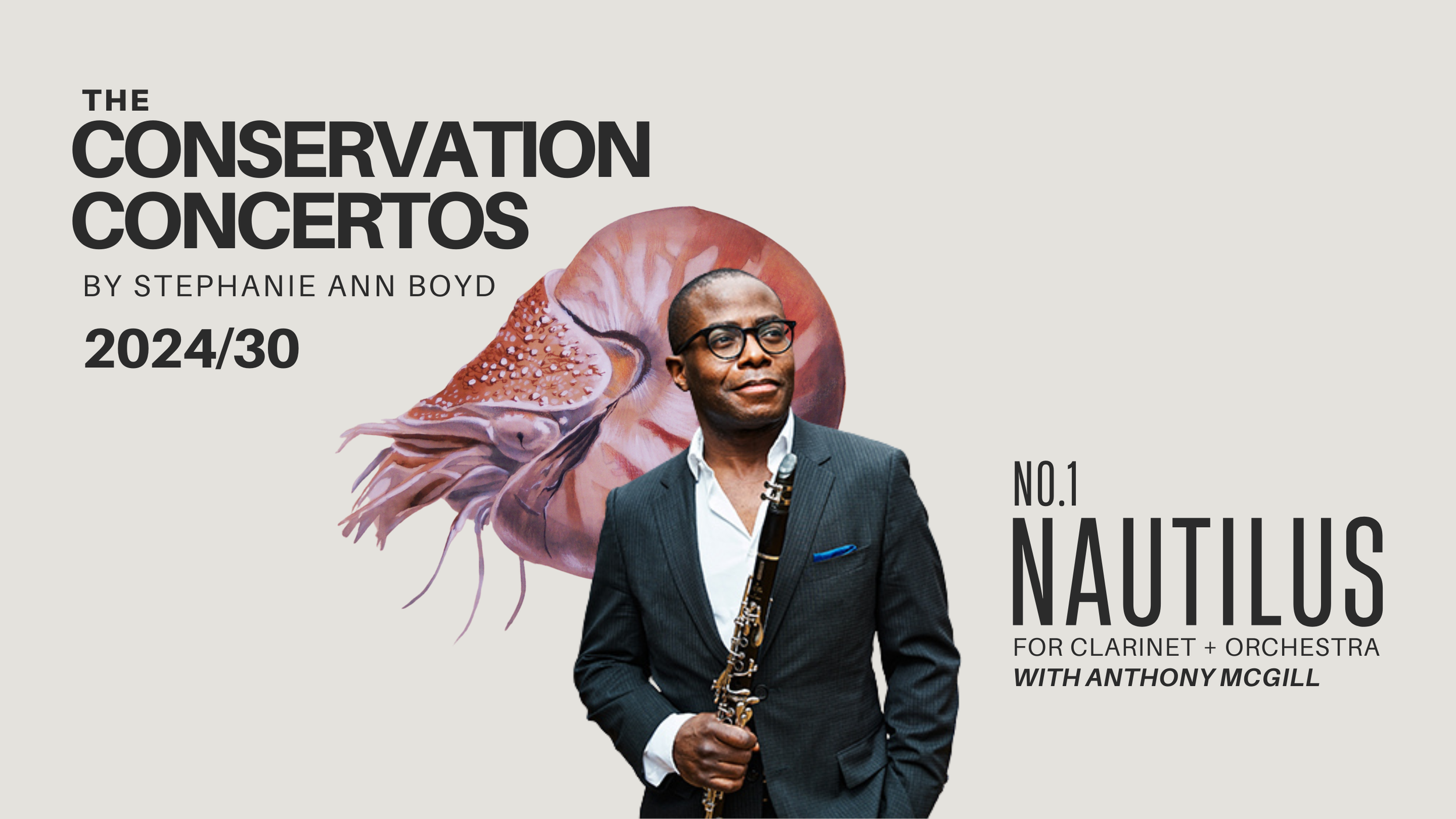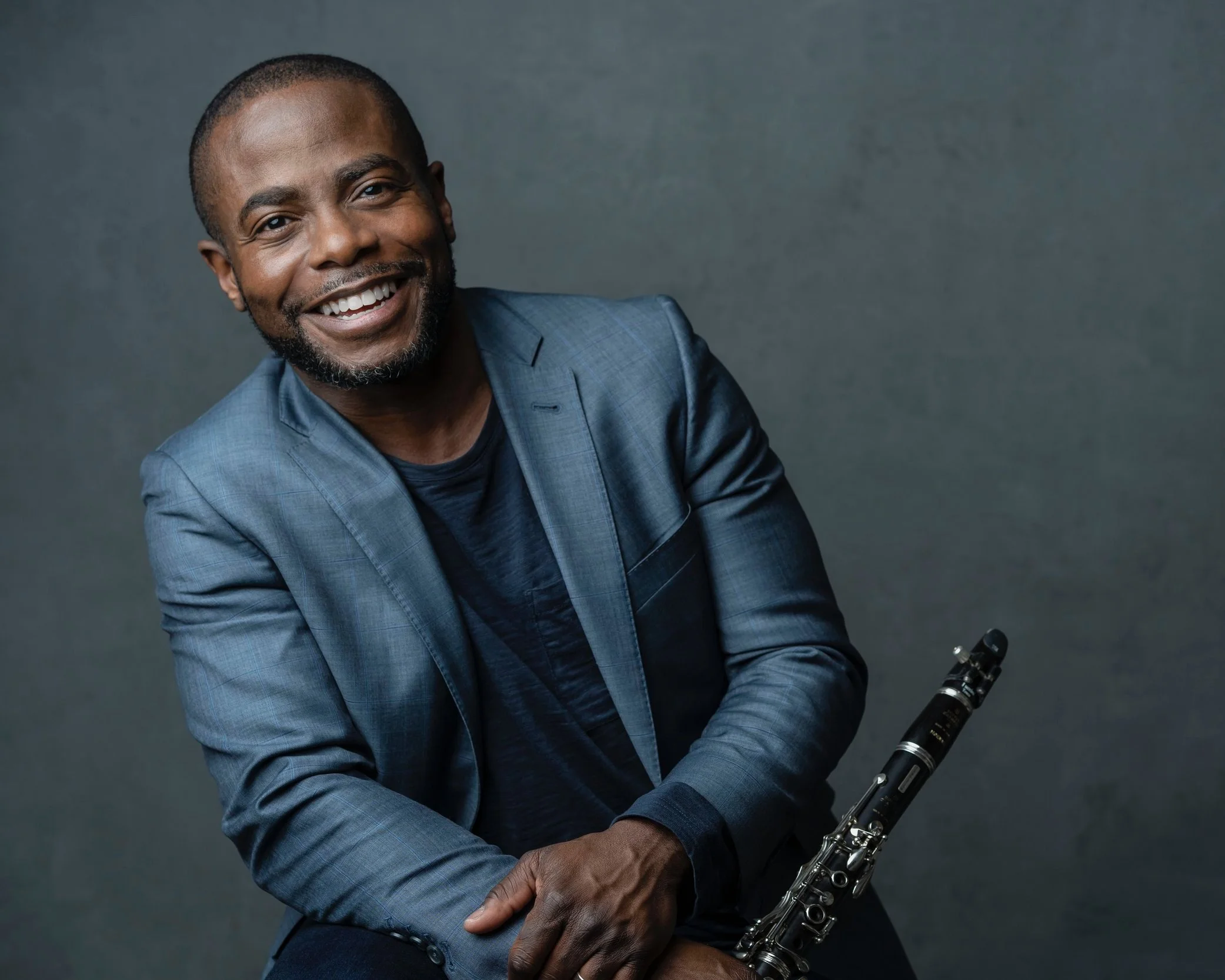The Conservation Concertos, Stephanie’s biggest project to date, are a set of works for solo instrument and orchestra being written over the next decade, each about a different nearly-extinct flora or fauna, or environmental concern.
Each concerto is about a subject close to its soloist’s heart. Pieces in the project’s pipeline include:
with Anthony McGill, for clarinet + orchestra
about the Nautilus
with Tammy Miller, for piano + orchestra
about Nearly-Extinct Flowers
with Masumi Rostad, for viola + orchestra
about Pernambuco Wood
with Tommy Mesa, for cello + orchestra
about Plastics

introduction
Anthony and I began dreaming up this piece in late May of last year, imagining which endangered species the clarinet might best be matched with. I mentioned the Nautilus because I had always been drawn to its gorgeous outer shell, the understated yet magical geometry of its interior, this idea that something so shy and contained could also be one of the most potent emblems of nature’s resiliency.
That idea stuck: “I’m a Cancer” (the constellation of the crab) he said, “so I really identify with being in one’s shell!” And as we talked about everything it could be, every other component of the project just came together and made a lot of sense:
from making short videos for our and the commissioning orchestras’ instagrams/tiktoks of Anthony describing how he practices the piece’s pedagogically significant moments—“Stephanie they also need to be ICONIC moments!”,
to cooking up a 40 minute presentation for concert weeks called Beyond the Stage where Anthony and I walk the audience through the fascinating behind-the-scenes of the piece and the process and stories and melodies from our collaboration,
to commissioning a Nautilus collage from my long-term collaborator Sasha Parfenova (who created the collages on this page!) for orchestras to be able to use for their marketing imagery needs,
And throughout the summer, as the piece began unfurling itself in my mind, Anthony kept running into the image of the nautilus: turns out many summer festivals use it as their logo...

The piece
The first of the Conservation Concertos––pieces which match the solo instrument with a nearly-extinct flora or fauna to augment our awareness to our connection and symbiosis with earth and our fellow inhabitants on the food chain way down below us—NAUTILUS centers upon one of our oldest yet still extant ancestors. Prized for its dazzling shell with its intricate chambers whose mathematical proportions show the visual elegance of fractals, the Nautilus has been on earth for hundreds of millions of years…and now we are only a few years away from losing this incredible creature thanks to humans poaching, humans polluting.
This piece maps the different ways we exist on this earth, in our present, past, and future, in long melodies and deep ocean hues.
I.
SHELL (YOU)
The first movement focuses on the journey we all have in our lives with ourselves. The solitary experiencing of our own joys and difficulties, growth and decay.
This movement is in the shape of a spiral, with themes coming back in new and larger ways each time, just like the themes and people within our lives.
II.
Generations as fractals through time (US)
The second movement is about family; how the self-solitude in the first movement opens up to encompass the people we care about, and the small miracle of how much we look like our parents and grandparents but how we inherit so much more from them on the inside as well. How our children are a continuous blossoming of the pest parts of us into the future.
Inspired by Anthony’s daughter, this movement is a lullaby. The generations really showed up for this one: I had been stalled for a few weeks on how to end this movement. The day after my grandmother—a composer herself and my dearest mentor—passed away in early 2024, I felt drawn to the piano and sure enough: the notes I needed made themselves known to me: twenty minutes later I had written the next several minutes of music.
III.
(WE) summon
The third movement widens our awareness finally from ourselves to our families to the earth around us: a grand summoning of all of us towards actions of love and caring.
Fast and ferocious, this movement is a rhythmics, which is my name for moments that groove and fly the whole speedy way through.

in the community:
Concert week
Behind the Stage, a 40 minute presentation where Anthony and Stephanie walk the audience through the fascinating behind-the-scenes of the piece and the process of collaboration, complete with Anthony playing a few excerpts and finishing with a Q and A session.
in the community:
residencies
College/University residencies can include:
panel discussion about the nautilus history and future with Anthony, Stephanie, and a biology professor at the university
composition and clarinet masterclasses
(see examples of Stephanie’s here and Anthony’s here)Behind the Stage, a 40 minute presentation where Anthony and Stephanie walk the audience through the fascinating behind-the-scenes of the piece and the process of collaboration, complete with Anthony playing a few excerpts and finishing with a Q and A session.
in the community:
Online
An Instagram Campaign about the making of the piece
Several short videos of Stephanie and Anthony discussing the work and Anthony explaining to viewers his approaches to practicing and performing several passages from the piece.Because the leaders of tomorrow are in youth orchestra today, young people and professionals alike will be able to get involved as “mini commissioners”: for contributions of $50 (students) and $100 (professionals), they’ll be named in the score and will receive the chamber music versions of the concerto: with piano, and with piano quintet.

THE ASSETS
Score and parts printed and delivered by Just A Theory Press
Nautilus collage by Sasha Parfenova (the creator of the collages on this page) for use in program and marketing visuals
Several short videos of Stephanie and Anthony discussing the piece
Stephanie will be working with an expert on each piece who specializes in the concerto’s subject matter so that the program notes will consist of not only accurate information about the subject’s current and projected future states, but also realistic, actionable advice on what audience members can do to help out, as well as information about the best charity to look into contributing to.

the DETAILS
The People
Hailed for his “trademark brilliance, penetrating sound and rich character” (New York Times), clarinetist Anthony McGill enjoys a dynamic international solo and chamber music career and is principal clarinet of the New York Philharmonic — the first African-American principal player in the organization's history. He is the recipient of the 2020 Avery Fisher Prize, one of classical music’s most significant awards, and was named Musical America’s 2024 Instrumentalist of the Year. American Stories, his album with the Pacifica Quartet, was nominated for a GRAMMY® for Best Chamber Music/Small Ensemble Performance.
McGill appears as a soloist with top orchestras, including the New York and Los Angeles Philharmonics, the Metropolitan Opera, and the Baltimore, Boston, Chicago, and Detroit Symphony Orchestras. He performed alongside Itzhak Perlman, Yo-Yo Ma, and Gabriela Montero at the inauguration of President Barack Obama, premiering a piece by John Williams. As a chamber musician, McGill is a collaborator of the Brentano, Daedalus, Guarneri, JACK, Miró, Pacifica, Shanghai, Takács, and Tokyo Quartets, and performs with leading artists including Emanuel Ax, Inon Barnatan, Gloria Chien, Yefim Bronfman, Gil Shaham, Midori, Mitsuko Uchida, and Lang Lang. He serves on the faculty of The Juilliard School and is the Artistic Director for Juilliard’s Music Advancement Program. He holds the William R. and Hyunah Yu Brody Distinguished Chair at the Curtis Institute of Music.
NYC-based composer Stephanie Ann Boyd (1990) and her music—which has been performed in all 50 states and has been commissioned by musicians and organizations in 37 countries—are on an adventure building musical projects and experiences that more fully connect the folks on stages, in classrooms, and across audiences, to the planet and with each other. Her current musical campaigns working on these endeavors include:
The Conservation Concertos which pair the solo instrument with a nearly-extinct flora or fauna. Nautilus, the inaugural concerto, is being written for New York Philharmonic Principal Clarinetist Anthony McGill.
Carnival of the Nearly-Extinct Animals, a new consortium work for orchestra which follows the size and structure of Saint-Seans’s iconic work. Movements talk and inspire about coral, bison, bees, whales, and other species you probably didn’t know that we’re very close to losing forever.
Lake of Muses for Detroit’s Acropolis Quintet about the history and future of the Great Lakes.
The 50 State String Orchestra Project, and the 50 State Symphonic Band Project, consortium projects through 2026 that involve writing for and coaching youth ensembles all across the US before their performances of The Lifecycle of Stars, for symphony band and Four Future Memories for string orchestra, which will receive its Carnegie Hall debut this spring.
Recent commissions include Sheltering Voices for the Eureka Ensemble, Everywoman: A Friedan Centennial Memoire about women’s rights leader Betty Friedan for the Peoria Symphony Orchestra while she was Composer in Residence for the 21/22 Season, and Julia Louisa Esther, the “suffragette symphony” for the Wyoming Symphony.
Boyd’s five ballets include works choreographed by New York City Ballet principal dancers Lauren Lovette and Ashley Bouder and include a ballet commissioned for the grand opening of the TWA Hotel at JFK Airport. A graduate of the New England Conservatory, Stephanie’s music has been praised as “a racing, brassy score” (New York Times), “attractive lyricism” (Gramophone), “[with] ethereal dissonances” (Boston Globe), “[music that] didn’t let itself be eclipsed” (Texas Classical Review), and “arrestingly poetic” (BMOP).


